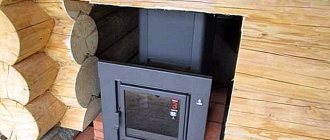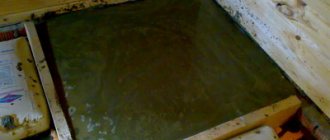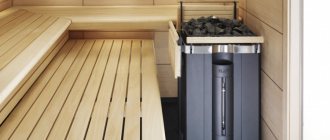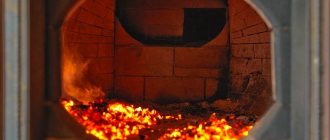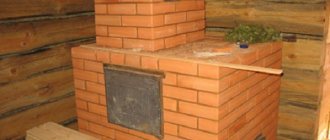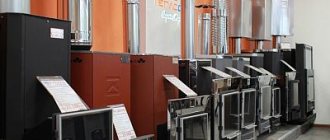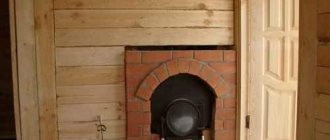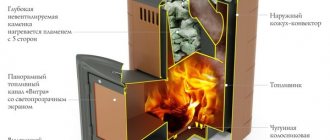Steam room lovers often wonder whether it is possible to heat a bath from the street, and if so, whether there are any advantages to this or whether such a device is very bad. In order not to beat around the bush, I will say right away that from the technical side such a device is quite possible and will not change the heating procedure of the steam room in any way. But, nevertheless, there are some nuances, and I will talk about them in this article.
Advantages of a design with an external firebox
A classic Russian bath involves the use of a real wood-burning stove, and not its imitation. And in order to create the necessary atmosphere in the steam room, a means of heating the room is installed directly in it. This is the only way to achieve the desired temperature for steaming the entire body.
It’s good when the stove is heated with selected wood. The room is saturated with an indescribable pleasant aroma. True, there is always a possibility that harmful gases generated during combustion will fill the steam room, despite the fact that the stove should work as an exhaust ventilation. And this happens anyway when the firebox door opens.
The second unpleasant moment is the garbage in the steam room, which cannot be avoided when bringing firewood into it. And manipulating the stove in a cramped room, when they are already taking thermal procedures and trying to relax, is completely inappropriate. Therefore, the option when the stove is heated from another room looks very attractive.
Firebox in the rest room Source cstor.nn2.ru
In addition, a stove in a bathhouse with a firebox in the dressing room has a lot of advantages:
- Not only the steam room is heated, but also the adjacent room.
- There is nothing stopping you from regularly adding firewood to the stove. This means crowded conditions and people in the steam room.
- It becomes possible to protect a hot oven with a safety screen. And this will avoid accidental burns.
- The steam room will be kept perfectly clean.
- In the room where the firebox is located, you can arrange a place for drying firewood. There are situations when such a problem is very relevant.
- The air in the steam room always remains clean and pleasant to breathe. After all, the steam in this case turns out to be light.
- The steam room will receive more usable space, since the space occupied by the open firebox door will be freed up.
- If desired, the firebox can be taken not only into the next room, but also outside.
The latter circumstance is especially relevant when you need to heat the bathhouse with coal instead of firewood. In this case, combustion products are more harmful and it is better that they do not even get into the dressing room. In addition, there is much more dirt from such fuel.
Taking the firebox outside Source oboiman.ru
The option has a significant disadvantage. In order to add fuel to the stove, you must interrupt the bathing procedures and leave the room. Therefore, this approach is justified in commercial organizations, when a special employee monitors the kindling. But since coal provides more heat than wood, some bathhouse owners deliberately accept certain inconveniences.
Having a certain skill, the stove in a bathhouse with a firebox from the dressing room is laid out independently from brick. This approach will support the traditional foundations of bath procedures, since the heater has always been considered an indispensable attribute of the Russian bath. But progress also brings its advantages, which are more practical.
For example, metal stoves heat up faster and therefore require less fuel. In addition, in steel structures, the outlet channel is already welded to the boiler and all that remains is to equip an opening in the wall for it. And some heavy cast iron stoves have a removable firebox. And this adds new possibilities when used.
Installation of a cast iron stove with a remote firebox Source oboiman.ru
Modern stoves are equipped with a firebox door with transparent protective glass. There are both disadvantages and advantages to this. Since such material does not heat up, in the closed position no heat enters the dressing room. To heat the room, you will either have to regularly open the door slightly or install an additional heater.
But if there are no problems with the temperature of the rest room, then such a design can serve as a fireplace. If you move chairs to the firebox, you can observe the fire through the transparent glass. This type of relaxation is especially pleasant after couples treatments.
See also: Catalog of companies that specialize in the design and installation of fireplaces and stoves
How to choose a stove for your home
Before purchasing such a device, you need to consider some points. Igor Izotov told Komsomolskaya Pravda how to choose a stove for your home . He advises paying attention to the following factors:
Oven type
It largely depends on what you need the oven for. For a home bath, simple heating in a room, or maybe for a storage garage. Wood-burning stoves are the most common type on the market . They have a simple design and give a pleasant smell when fired. Just remember - you need to install a chimney for it, which will have to be cleaned periodically. Find a place for it. Don't forget that you will need a lot of good firewood.
Gas ovens are smaller. They do not need firewood, but if the stove runs, for example, on natural gas, then they will have to lay a gas pipe and buy gas cylinders. Some of these stoves have gas burners, but for some you will have to buy them in addition.
There are also electric ovens . They are suitable for home saunas - “Finnish”. This stove operates on stones, which are heated by electric heating elements. The room warms up quickly, but the downside is that there is a lot of electricity consumption.
Heat retention time
An important point is the speed of warming up. Especially if you are making a steam room. Brick stoves retain heat for a long time, but these require longer heating and installation may require extra care. Most home stoves are metal. They heat up quickly, but also lose heat if the fire is not maintained. A cast iron stove also retains heat for a long time, but it will also cost more.
Compactness
Again, it all depends on where you place the stove. If you need heat in a workshop or warehouse, you can take a heavier and larger device. If it’s for a house or a small bathhouse, then choose a compact option. Make sure there is somewhere to connect the chimney.
Power
This point also depends on the volume of the house. On average, for a private house of 100 sq. m requires a furnace with a power of approximately 10 kW. In this case, the efficiency should be 100%. If you have a smaller room, then the power may be less. It is logical that more heat will be in the place where the stove is installed.
Safety requirements
Installing a sauna stove with an external firebox requires the introduction of additional protective measures. But we also shouldn’t forget about the basic ways to comply with fire safety in order to protect people visiting the steam room from injury, and yourself from penalties from supervision. And the implementation of all the recommendations prescribed in the sixth chapter of SNiP number 41-01-2003 will help in this.
Installation of an iron stove with the firebox removed to the dressing room Source oboiman.ru
And in a few words, all the basic requirements boil down to the following:
- A reliable foundation is erected under the main structure of the furnace, which should be adjacent to the wall of the room where the firebox will be installed.
- The remote fuel duct made of iron should only pass through a stone wall. Therefore, if the latter is made of wood, it is necessary to equip a niche in it, which is lined with brick.
- The distance between the metal parts of the stove and the wooden wall must be at least 40 cm.
- This parameter can be reduced if the fuel channel is laid with a reliable insulator. For example, basalt wool or cement-fiber material. If the insulation thickness is at least 5 cm, then the distance can be reduced to 25 cm. When an even thicker gasket is used, then even to 12.5 cm.
- Before the firebox, a steel sheet with dimensions of at least 40x80 cm must be laid on the floor. It will not only prevent fire from coals falling out of the stove, but will also help in removing debris from the fuel.
Steel sheet in front of the firebox Source remontnik.ru
- The distance from the stove to the ceiling of the steam room must be at least 120 cm.
- The edge of the combustion door should be 125 centimeters from the nearest door.
- A homemade iron stove must be lined with bricks.
This last measure will help to avoid a fire in the room if, through negligence, wooden objects, of which there are plenty in the sauna room, interact with the stove body. Factory-made products are usually protected by double walls.
Step-by-step procedure for self-construction
Wooden structures must also be protected with metal.
If the weight of the equipment is no more than 0.4 tons, taking into account the stone lining and tiles, and the floor is made of boards 4 cm thick, you can do without installing a podium. Ceramic tiles are laid on asbestos sheets on the floors. Usually, stainless steel stoves weigh a little, but for cast iron fireplaces, pouring a foundation is required. The distance from the bottom of the stove to the flooring in case of installation without a base must be at least 10 cm.
Distance to wooden roof elements:
- 130 mm - from brick pipes;
- 250 mm - from ceramics;
- 130 mm - from ceramic smoke ducts with fire insulation.
The steam room is characterized by high humidity, so the floor in it is made with a slope away from the wall behind which the stove stands. The flooring under the fireplace is waterproofed on all sides so that water does not flow in at its level from the side of the shower, washing room, or steam room.
Foundation installation
A heavy brick stove needs its own foundation.
The foundation is made in such a way that it is twice the area of the bottom of the stove. The base material is concrete and red ceramic brick. The base for the stove should not be connected to the foundation of the walls or log house.
Step-by-step instructions for building a foundation for a firebox in a bathhouse:
- mark the construction site taking into account the standard dimensions;
- an opening is cut out in the wall, part of the floor is dismantled;
- dig a foundation pit with a depth of 50 cm plus 20 cm for the installation of a sand-concrete cushion;
- backfill with sand, crushed stone and tamper;
- lay waterproofing so that it covers the vertical walls before pouring concrete;
- install a frame frame made of reinforcement.
Concrete is poured flush with the ground, then protective layers are made. If the surface is raised to the floor level in the bathhouse, temporary formwork made of wood or chipboards is installed. The foundation will gain full strength in 28 days.
Filling the floor, insulating the walls
Two layers of waterproofing are placed on top of the concrete; roofing felt is used, which is glued to molten resin or factory-made bitumen mastic. A cement-sand screed is made on the surface, the thickness of which cannot be less than four centimeters. A layer of one or two rows of brickwork is made under the stove.
The ends and planes of adjacent walls and wooden partitions are insulated from high temperatures. To do this, take asbestos or install a layer of mineral wool and heat-resistant plasterboard (gray). Mineral wool is protected with a film from moisture, because when wet it loses its heat insulating properties.
Stove installation
For an iron stove, a protective screen is laid out from refractory brick.
If the bathhouse is just being built, they install a stove, line it with bricks and then make a wall between the dressing room and the steam room. If the stove is installed in a finished building, the instructions suggest a different work plan.
Installing a stove in a bathhouse with your own hands:
- study the technical passport, which contains the recommended parameters for the distance to partitions and ceilings;
- a hole for the combustion channel is knocked out in the wall, brickwork is done inside it;
- install the unit on the prepared base, then make a brick shell around the body;
- foam the joints between wood and masonry;
- install a protective screen around the perimeter of the stove at a distance of 10 - 50 mm from the walls of the firebox.
Safety reflectors are made of steel or cast iron; front and side models are available. The screen reduces the temperature to +80 - +100°C, so the gap to the wooden partition can be reduced to 0.5 m.
Chimney installation
When the channel passes through the wall, the ceiling is lined with bricks and wrapped with a heat insulator.
Types of chimneys:
- mounted structures are placed on top of the furnace; ceramics and metal sandwich pipes are used for them;
- main chimneys are built separately in the form of a brick channel;
- wall channels are made in the thickness of vertical fences.
For metal and cast iron sauna stoves, the first type is most often used. Attached to the stove using a special adapter. The connection to the roof is made using aluminum boxes and trims.
Construction of a brick kiln
Having the skill of bricklaying, you can install the stove in a bathhouse with a firebox from the dressing room yourself. To do this, you need to stock up on the necessary materials and tools. You will need clay, sand and fire bricks. You will also need grates and doors for the firebox. You can’t do without a steel corner.
The work cannot be completed without a construction trowel and levels of different lengths. And initially you need to decide on the layout of the furnace. If your work experience is minimal, then it is better to abandon sophisticated projects and stick to the simplest ones.
Laying a stove for a bath Source remontik.org
Foundation for a sauna stove
The installation of any stove begins with the foundation, and when the floor of a country house is concrete, this already solves one problem - there is no need to make a special foundation. Here you can only decorate the floor with ceramic decorative tiles for beauty and ease of cleaning. It was a completely different story when we built a wooden house.
Here you already need to take care of sufficient thermal insulation of the floor. Fire safety is also of paramount importance: metal sheets must occupy a space of at least 40 cm in front of the door. This is necessary in order to avoid coals falling out of the stove onto the wooden floor.
Is a foundation always needed for a stove?
If the stove-heater does not exceed 700-750 kg, there is no need for a foundation. Steel fireboxes supplied by online stores are still usually less than this weight. But if you love cast iron structures, you most likely cannot do without pouring concrete. Likewise, a foundation will be required if the firebox is surrounded by large brickwork. In any case, in controversial situations it is better not to neglect safety and carry out the appropriate work.
The procedure for carrying out work on the construction of the foundation
The stove foundation is an important element of the future bathhouse. The quality of work on its installation greatly influences the following parameters:
- stove safety;
- its service life;
- correct operation of all components of the heating device.
Let's look at the step-by-step procedure for constructing a stove bath foundation:
- At the location where the firebox is installed, a pit is prepared, the perimeter of which is 15-20 cm larger than that of the stove being installed, and the depth is 50 cm;
- After compaction, the bottom of the pit is sprinkled with a mixture of crushed stone and sand;
- Waterproofing is laid in the form of a polyethylene film;
- The road mesh reinforcing the foundation is attached to the reinforcement using wire or welding. The mesh frame has a perimeter 5-7 centimeters smaller than that of the oven being created;
- A concrete solution is prepared from a mixture of sand and cement in a ratio of 3:1, which is used to fill the foundation pit;
- The leveling is carried out using a vibrating screed, and then the result is checked using a level;
- When the solution has hardened, it is covered with two layers of roofing material;
- Using fireclay bricks, they form the basis for the future furnace.
Installation of a metal structure
Today, manufacturers produce a large number of designs of iron stoves for baths. And options with the removal of the firebox to an adjacent room are especially popular among buyers. In addition, the remote channel is often equipped with a door with panoramic glass. And this helps to monitor the kindling process without opening the stove.
The installation of a metal stove in a bathhouse takes place on a foundation located near the partition. In the latter, an opening is cut for the fuel channel. Before installation, all surfaces are carefully insulated to protect them from excessive heating.
For the same purposes, metal stoves are often lined with brick. But this measure is more common for home-made structures. Because factory-made ovens have very reliable protection and do not need additional protection. Therefore, their lining is purely decorative.
Video description
The video will show what a stove looks like in a bathhouse with a firebox in the dressing room, metal, lined with brick:
Exiting the firebox through a stone wall
A window is cut out in a concrete or brick partition. Its location is precisely measured using the dimensions of the oven. Since the designs of stoves with remote fireboxes are varied, the height of the window can vary from 40 to 60 cm. And the width can be from 25 to 50 cm.
But to the exact dimensions of the external firebox you should always add 20 mm in each direction. This must be done because metal expands when heated. And all gaps are sealed with elastic, heat-resistant material. The most commonly used is asbestos cord.
In addition, it is necessary to install a metal fence. All free space between the fuel channel and the facing material is sewn with a steel sheet. Since most often all surfaces in the bathhouse are covered with clapboard, the distance from the wood to the firebox should be at least 25 cm. Taking into account that a fairly thick insulator is used.
Lining the stove with bricks step by step
- We make markings on the floor, taking into account a distance of 3-4 cm from the firebox.
- It is necessary to lay waterproofing around its perimeter to help the floor dry.
- After thoroughly mixing the concrete solution, spread it around the perimeter.
- We lay the bottom row of bricks on it. Next, taking into account all the features of the brickwork construction, the walls of the furnace are erected. Sealing of joints is carried out using a solution that has not yet hardened.
The stove is ready for use after all layers of masonry have completely dried.
Video description
For information on how to install an iron stove in a bathhouse with a firebox from the dressing room, watch this video:
Firebox outlet through a wooden wall
If the partition is wooden, then you can’t get away with a window. It will be necessary to create a full opening to the floor, which is then covered with bricks. And already in the masonry a window for the fuel channel is equipped.
To find the height and width of the opening, you need to mark exactly where on the wall the door to the firebox will be located. Having transferred its contours to the surface of the partition, you need to add 25 cm up and to each side. And already using these marks to cut out the opening.
When creating a window for the fuel channel, which is required by installing an iron stove in a bathhouse, you must follow the recommendations described above.
What to do when the wall thickness is significant
It happens that the stove design has a very short fuel channel. And if the wall thickness is significant, then the door does not extend beyond its surface. In this case, it is necessary to cut an opening in the wall and lay a stone niche made of decorative bricks in it.
And for reliability, a flat jumper is installed above the masonry. A metal sheet with a thickness of 8 to 10 mm is selected for it. As in previous cases, you must remember to seal all gaps with asbestos materials.
Unbearable firebox - has the right to be
A non-removable firebox is not the most convenient, but a useful option. Can become a key part of the design.
Proponents of the stove being located entirely in the steam room can quite reasonably point out the following advantages:
- The temperature in the steam room is easier to regulate; you don’t need to go anywhere for this;
- Air circulation in the steam room is better (this is true if there is an oxygen flow to the stove from the street; if there is no incoming flow, then the air in the steam room will be depleted and heavy);
- The question of heat loss through a hole in the wall does not arise; there is no need to carefully insulate it;
- The stove in a spacious steam room can be moved further away from the wooden walls, thereby reducing the risk of fire;
- You can additionally increase the heat by opening the firebox door;
- The overall design of the bathhouse is more economical and simpler to implement;
Briefly about the main thing
Exiting the furnace firebox to the dressing room is largely considered a practical solution. In this case, two rooms are heated at once. Therefore, the rest after taking paired procedures is more comfortable. It is also easier to maintain the required temperature in the steam room and restore order. Because there is much more freedom of movement in the waiting room.
The most difficult thing to implement is the classic version of a brick stove, since its construction requires some experience. But if you follow all the recommendations of experts, you can build a fully functional stove. And also take care of the fire safety of the premises.
It is much easier to use a ready-made factory-made oven. It is more reliable and even compact. Its installation in a steam room is not difficult. The only problem will be arranging a niche for the fuel channel. But following the instructions of specialists, covering the opening with bricks and insulating it will not be difficult even for a beginner in this matter.
Ratings 0
